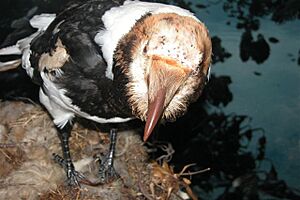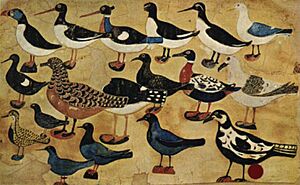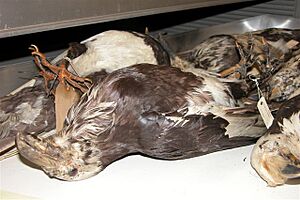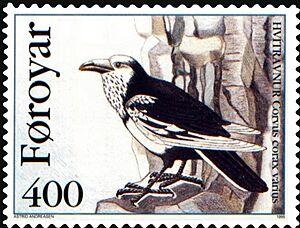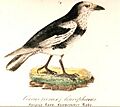Pied raven facts for kids
Quick facts for kids Pied raven |
|
|---|---|
 |
|
| Pied raven type specimen, shot 24 September 1869. Zoologisk Museum, Copenhagen | |
| Conservation status | |
| Scientific classification | |
| Kingdom: | |
| Phylum: | |
| Class: | |
| Order: | |
| Family: | |
| Genus: | |
| Species: |
C.c.varius
|
| Subspecies: |
C. corax varius
|
The pied raven (Corvus corax varius morpha leucophaeus) was a special type of common raven that lived only on the Faroe Islands. It had unique white patches on its feathers, especially on its head, wings, and belly. Its beak was also light brown. This bird was a "colour morph," meaning it was a different colour version of the regular raven.
The last time anyone officially saw a pied raven was in 1902, which means it is now extinct. Regular all-black ravens, which look similar but without the white patches, are still common in the Faroe Islands and Iceland.
Contents
History of the Pied Raven
The pied raven was given several scientific names over time. Scientists like Louis Pierre Vieillot and Johann Georg Wagler gave it names like Corvus leucophaeus and Corvus leucomelas. Today, it is known as Corvus corax varius morpha leucophaeus. This long name helps scientists understand that it was a specific colour variation of the common raven.
What Did the Pied Raven Look Like?
In the Faroese language, the pied raven was called hvítravnur, which means "white raven." An older name was gorpur bringu hvíti, meaning "white-chested corbie."
Ravens from Iceland and the Faroe Islands often have more white at the base of their feathers than other ravens. But on the Faroe Islands, a special change in their genes caused some ravens to have about half of their feathers completely white. This was different from albinism, where an animal is completely white due to a lack of colour. The pied raven's unique look was a regular part of the raven population there.
The first mention of the pied raven seems to be in an old Faroese poem from before the 1500s called Fuglakvæði eldra. Later, people like Lucas Debes (in 1673) and Jens Christian Svabo (in 1781/82) also wrote about it. In 1828, Carl Julian von Graba said he saw ten pied ravens himself. He noted that while they were not as many as the black ravens, they were still quite common.
A famous Faroese painter named Díðrikur á Skarvanesi created a series of bird paintings called Fuglar. In his painting 18 fuglar ("18 birds"), you can see a pied raven in the bottom right corner. This painting is now displayed at the Listaskálin museum in Tórshavn.
Why Did the Pied Raven Become Extinct?
The pied raven was very interesting to collectors because of its unique look. During the 1800s, these birds were hunted specifically because they could be sold for a lot of money. For example, a local official named Hans Christopher Müller once paid two Danish rigsdaler for a stuffed pied raven. This was a good amount of money for farmers in the Faroe Islands, making it profitable to hunt them.
Ravens in general were also hunted because people saw them as pests. In the mid-1700s, a royal rule said that every man in the Faroe Islands who could hunt had to shoot at least one raven (or two other birds of prey) each year. If they didn't, they would have to pay a fine.
The last pied raven that was officially confirmed was shot on November 2, 1902, on the island of Mykines. After that, there were a few reports of white ravens being seen, but they didn't have the special black-and-white pattern of the pied raven. Some ravens today can be all-white, but this is different from the pied raven's unique markings. Because of this, 1902 is generally considered the year the pied raven became extinct.
The pied raven was a colour variation, meaning it only had a few small genetic differences from the black ravens. It's possible that the genes for the white patches are still present in some black ravens, but they are "hidden." This means that, in theory, a pied raven could be born again someday, though it's very unlikely. The raven population in the Faroe Islands is quite small, with only about 200–300 breeding pairs.
Today, there are 16 known museum specimens of the pied raven around the world. Six are in the Zoologisk Museum in Copenhagen, Denmark. Four are in the American Museum of Natural History in New York, United States. Other museums in Sweden, the Netherlands, and Germany also have specimens.
To remember this unique bird, the Postverk Føroya (Faroe Islands postal service) released a special postal stamp (FR 276) featuring a pied raven on June 12, 1995. The stamp was designed by the famous Faroese artist Astrid Andreasen.
Images for kids



